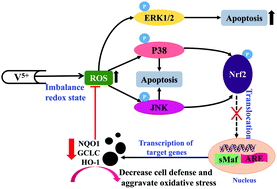Vanadate oxidative and apoptotic effects are mediated by the MAPK-Nrf2 pathway in layer oviduct magnum epithelial cells
Abstract
Vanadium is a metal of high physiological, environmental and industrial importance. However, vanadium-induced oxidative stress can reduce the egg quality of poultry, and be potentially harmful to humans, and the underlying mechanism is not clear. In this study, we investigated the underlying relationship between the oxidant-sensitive mitogen-activated protein kinase (MAPK) signaling pathway and vanadium-induced oxidative stress in oviduct magnum epithelial (OME) cells. Cultured OME cells were treated with 100 μmol L−1 vanadium and/or MAPK inhibitors [P38 MAPK inhibitor, SB203580; extracellular regulated protein kinase 1 and 2 (ERK1/2) inhibitor, U0126; c-JUN N-terminal kinases (JNK) inhibitor, SP600125]. Cell viability, apoptosis, and generation of reactive oxygen species (ROS) were assessed using flow cytometry. The expression of oxidative stress-related genes and their proteins was measured by reverse transcription-polymerase chain reaction and western blotting. Vanadium treatment reduced cell viability, whereas pretreated OME cells with SB203580 and U0126 prevented the reducing effect of vanadium on cell viability (P < 0.05). Likewise, MAPK inhibitors effectively suppressed vanadium-induced apoptosis and ROS generation (P < 0.05). In the OME cells treated with vanadium, SB203580 (P < 0.05) and SP600125 (P = 0.08) increased catalase activity by 89.3% and 55.3%; SB203580 and U0126 increased (P < 0.05) glutathione peroxidase activity by 44.9% and 51.1%, respectively. Incubation of OME cells with MAPK inhibitors also prevents malondialdehyde concentration increase and lactic dehydrogenase activity decrease in response to vanadium (P < 0.05). Vanadium downregulated P38, ERK1/2, JNK, Nrf2, sMaf, GCLC, NQO1 and HO-1 mRNA expression (P < 0.05). In contrast, inhibition of JNK with SP600125 upregulated P38, ERK1/2, JNK, Nrf2, GCLC and HO-1 mRNA expression (P < 0.05); inhibition of P38 with SB203580 upregulated JNK, NQO1 and HO-1 mRNA expression (P < 0.05); and inhibition of ERK1/2 with U0126 upregulated ERK1/2, GCLC and HO-1 mRNA expression (P < 0.05). Moreover, phosphorylation of P38, ERK1/2, JNK, and Nrf2 proteins was enhanced by V incubation; however, SP600125 blocked the phosphorylation of these proteins, whereas SB203580 blocked the phosphorylation of P38 and Nrf2. These results indicate that vanadium inducing oxidative stress in OME cells might be, at least, associated with the phosphorylation of the P38MAPK/JNK-Nrf2 pathway, which reduces the expression of phase II detoxifying enzymes.



 Please wait while we load your content...
Please wait while we load your content...